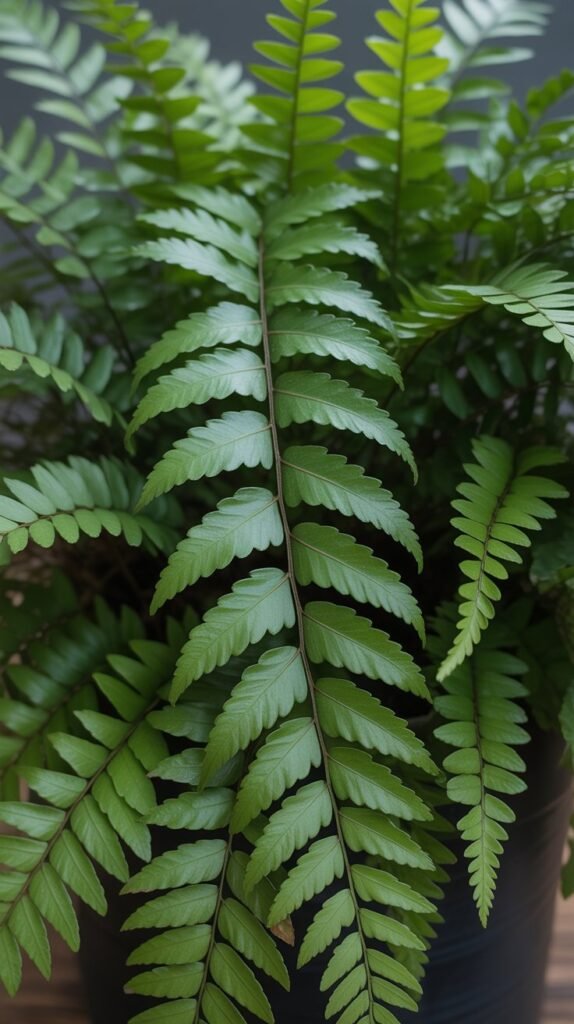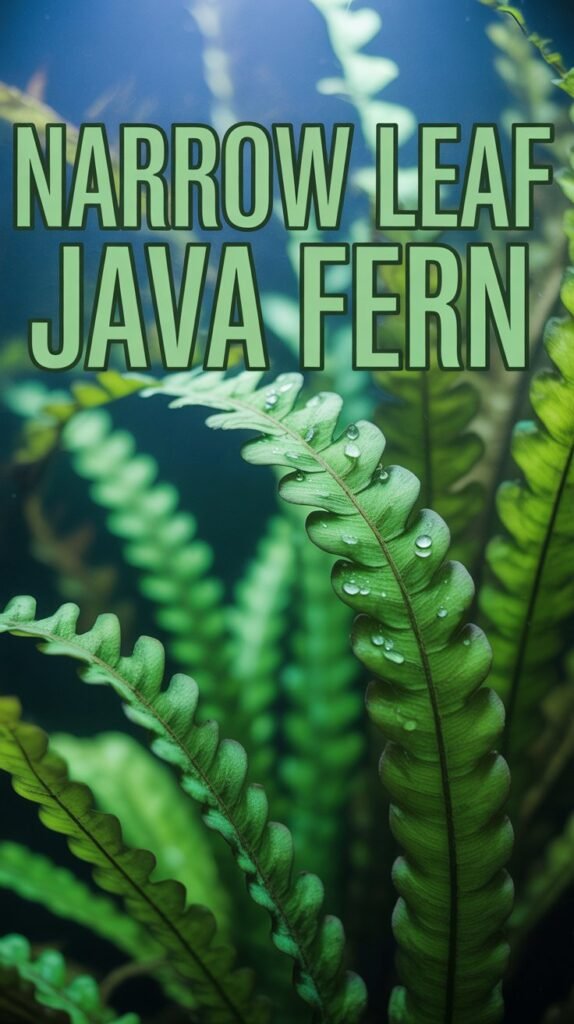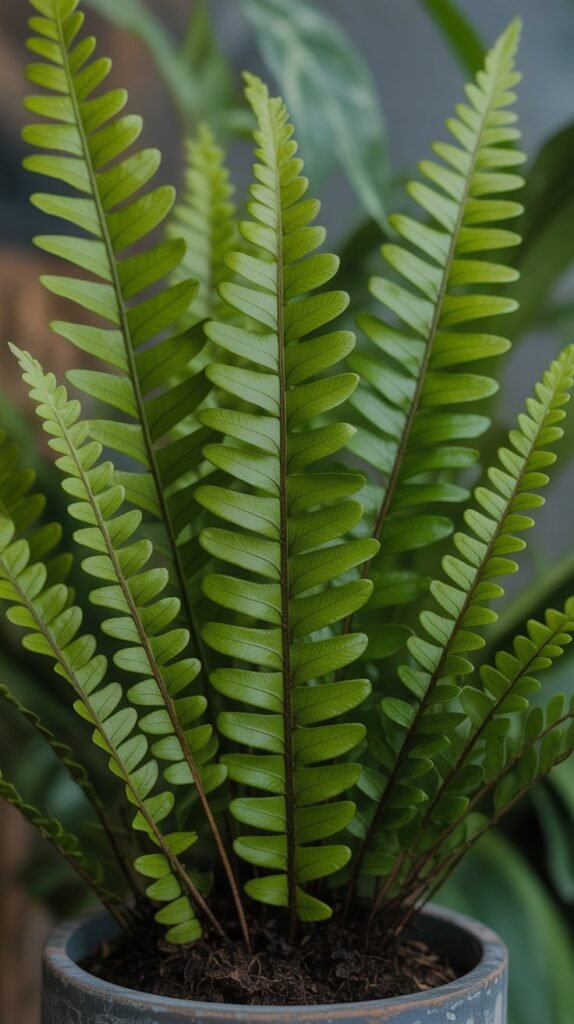When it comes to aquascaping, few plants are as versatile, hardy, and visually appealing as the Narrow Leaf Java Fern. Known scientifically as Microsorum pteropus ‘Narrow Leaf’, this aquatic plant is a popular choice among aquarium hobbyists for its elegant, slender leaves and low maintenance needs. Whether you’re a beginner aquarist or a seasoned tank designer, this plant brings a natural, lush look to your aquarium with minimal effort.
In this comprehensive guide, we’ll explore everything about the Narrow Leaf Java Fern—its origin, care, ideal conditions, propagation, compatibility with tank mates, and much more.
What Is a Narrow Leaf Java Fern?
The Narrow Leaf Java Fern is a variation of the traditional Microsorum pteropus, a freshwater plant species native to tropical regions of Southeast Asia. Found along riverbanks, shaded streams, and submerged rocks, this plant thrives in humid, tropical environments with moderate water flow.
The “narrow leaf” variant is characterized by its long, thin, and pointed leaves that grow up to 20–25 cm in length. These leaves give aquariums a graceful, vertical texture, ideal for background or midground aquascaping. It’s a rhizomatous plant, meaning it grows from a horizontal stem (the rhizome) that should never be buried in substrate.
Why Choose the Narrow Leaf Java Fern?

Here are the top reasons why aquarists around the world love this plant:
- Easy to Grow: It’s a slow-growing, hardy plant that adapts to various tank conditions.
- Low Maintenance: Does not require CO₂ injection or special fertilizers.
- Algae-Resistant: Its thick leaves are less prone to algae growth.
- Versatile Placement: Can be attached to driftwood, rocks, or aquarium decorations.
- Great for Beginners: Perfect for first-time plant keepers or those with limited time.
- Enhances Aquascape Aesthetics: The slender leaves add elegance and depth to any tank setup.
Appearance and Growth Habit
The Narrow Leaf Java Fern has a more delicate appearance than the standard Java Fern. Its leaves are typically 0.5–1 cm wide and grow upward in graceful, arching patterns. The rhizome creeps horizontally and anchors to surfaces using root-like holdfasts.
Unlike most aquatic plants, it does not grow in the substrate. Instead, the rhizome must remain exposed to allow proper nutrient absorption directly from the water column. When planted correctly, it grows steadily, forming dense clusters over time.
Under ideal conditions, the plant will produce new plantlets on mature leaves, which eventually detach and grow independently—a unique propagation trait that adds to its charm.
Ideal Tank Conditions for Narrow Leaf Java Fern
While this plant is adaptable, creating optimal conditions helps it thrive beautifully. Here’s how to set up your aquarium for success:
1. Tank Size
- Suitable for tanks of 10 gallons and above.
- Works best as a background plant in nano aquariums or a midground accent in larger tanks.
2. Lighting
- Low to moderate light levels are ideal.
- Avoid direct, intense lighting, which can lead to leaf burn or excessive algae.
- A 6–8 hour light cycle daily is sufficient.
3. Water Parameters
- Temperature: 20–28°C (68–82°F)
- pH Level: 6.0–7.5
- Hardness: Soft to moderately hard water (3–8 dKH)
This flexibility makes it suitable for a wide range of tropical freshwater aquariums.
4. Water Flow
- Prefers gentle to moderate water flow, similar to its natural habitat in rivers and streams.
- Strong currents should be avoided as they may damage delicate leaves.
5. Substrate
- Since the plant does not root in the substrate, gravel or sand type doesn’t matter.
- You can use rocks, driftwood, or aquarium décor as an anchor point for the rhizome.
6. CO₂ and Fertilization
- Does not require CO₂ injection, though it can enhance growth.
- Liquid fertilizers containing micronutrients like potassium and iron can promote leaf health.
- Avoid root tabs since nutrients are absorbed through leaves and rhizomes.
How to Plant a Narrow Leaf Java Fern

Planting this fern correctly ensures it grows strong and remains healthy. Here’s a simple step-by-step method:
- Choose an Anchor Surface: Select driftwood, rock, or ornament.
- Position the Rhizome: Lay the rhizome flat against the surface.
- Attach the Plant: Use fishing line, cotton thread, or aquarium-safe glue to hold it in place.
- Avoid Burying the Rhizome: Ensure it stays above the substrate, as burying it causes rot.
- Wait for Natural Attachment: Within 2–3 weeks, the roots will grip the surface naturally.
Once attached, you can remove the thread or let it disintegrate over time.
Maintenance and Care Tips
Even though the Narrow Leaf Java Fern is low-maintenance, regular care keeps it thriving for years.
1. Pruning
Trim older or damaged leaves near the base to encourage new growth. Avoid cutting the rhizome unless propagating.
2. Cleaning
Dust and debris can accumulate on leaves. Gently wipe or rinse them during water changes to prevent buildup.
3. Algae Control
Though resistant, algae can still form under high light. Maintain balanced lighting, avoid overfeeding fish, and ensure consistent water changes.
4. Nutrient Balance
Use liquid fertilizers once every 2–3 weeks if the plant shows slow growth or pale leaves.
5. Regular Water Changes
Perform 20–30% water changes weekly to maintain water quality and provide trace nutrients.
Propagation of Narrow Leaf Java Fern
Propagation is one of the most exciting aspects of this plant. It occurs naturally and easily.
1. Leaf Propagation
Mature leaves develop tiny plantlets at the tips or edges. These miniature plants eventually grow roots and can be detached when large enough to handle.
2. Rhizome Division
- Cut the rhizome into sections using sterilized scissors.
- Ensure each section has several healthy leaves.
- Reattach each portion to a new surface in the tank.
Both methods guarantee successful propagation without special tools or techniques.
Common Problems and Solutions
Even the toughest plants can face challenges. Here are some common issues and how to fix them:
1. Rhizome Rot
- Cause: Burying rhizome in substrate or poor water circulation.
- Solution: Unbury and reattach to a rock or driftwood. Remove rotted parts.
2. Yellowing Leaves
- Cause: Nutrient deficiency (especially iron or potassium).
- Solution: Use a balanced liquid fertilizer.
3. Brown or Transparent Leaves
- Cause: Intense lighting or lack of nutrients.
- Solution: Adjust lighting duration and supplement fertilizers.
4. Algae on Leaves
- Cause: High light and excess nutrients.
- Solution: Reduce light intensity, introduce algae eaters (like Amano shrimp or Otocinclus), and maintain cleanliness.
Tank Mates for Narrow Leaf Java Fern

This plant is non-aggressive and compatible with most freshwater tank inhabitants.
Ideal Tank Mates Include:
- Guppies
- Tetras
- Bettas
- Corydoras catfish
- Shrimp (Amano, Cherry, Ghost)
- Snails (Nerite, Mystery)
Avoid:
- Large herbivorous fish like Goldfish or Cichlids (some may nibble on leaves).
Its sturdy, bitter-tasting leaves make it less appealing to plant-eating fish, enhancing its survivability.
Aquascaping Ideas Using Narrow Leaf Java Fern
This plant’s slim, dark-green leaves make it perfect for natural-looking layouts. Here are some design inspirations:
1. Driftwood Forest
Attach multiple ferns to driftwood branches to mimic a forest underwater. It gives your tank a wild, jungle-like vibe.
2. Rock Garden
Anchor Java Ferns to stones or lava rocks to create a minimalist, zen-style scape.
3. Midground Accent
Use it behind carpeting plants or beside taller stems for contrast.
4. Shrimp Habitat
Dense fern clusters offer shelter and grazing surfaces for shrimp colonies.
5. Mixed Fern Layout
Combine with other fern types like Windelov or Trident Java Fern for layered textures.
Benefits of Narrow Leaf Java Fern in an Aquarium
Adding this plant isn’t just for looks—it provides real ecological and health benefits to your tank.
- Oxygenation: Improves oxygen levels for fish and beneficial bacteria.
- Nutrient Absorption: Helps control excess nitrates, maintaining water quality.
- Shelter and Breeding Grounds: Offers hiding spaces for fry and shrimp.
- Algae Reduction: Competes for nutrients that algae depend on.
- Stress Reduction: Dense greenery reduces fish stress and aggression.
Comparing Narrow Leaf Java Fern with Other Variants
| Variant | Leaf Shape | Size | Difficulty | Growth Rate |
|---|---|---|---|---|
| Regular Java Fern | Broad, thick | 20–35 cm | Easy | Moderate |
| Narrow Leaf | Thin, pointed | 15–25 cm | Very Easy | Slow |
| Windelov Java Fern | Frilled leaf tips | 15–20 cm | Easy | Moderate |
| Trident Java Fern | Multi-lobed leaves | 15–25 cm | Easy | Moderate |
The Narrow Leaf version stands out for its slender, elegant appearance and compact growth, making it suitable for smaller tanks and minimalist designs.
Expert Tips for Stunning Growth
- Attach multiple small ferns instead of one large clump for faster spreading.
- Combine with mosses like Java Moss or Christmas Moss for texture contrast.
- Maintain stable water parameters; sudden temperature changes can stunt growth.
- Use driftwood with natural grooves for easy attachment.
- Avoid copper-based medications—they can harm the plant.
Conclusion
The Narrow Leaf Java Fern is a timeless favorite in the aquascaping world. Its elegant appearance, easy care, and adaptability make it perfect for both beginners and professionals. Whether you’re creating a lush tropical layout or a minimalist planted tank, this fern adds natural beauty and ecological balance.
With proper lighting, moderate flow, and a little patience, your aquarium will flourish with vibrant green leaves swaying gently in the current—turning your underwater world into a serene masterpiece.
FAQs About Narrow Leaf Java Fern
1. Can Narrow Leaf Java Fern grow without CO₂?
Yes. It grows well without CO₂ injection, though additional CO₂ can enhance leaf color and growth speed.
2. Why are the leaves turning brown?
Brown leaves indicate old age or too much light. Trim them off and adjust lighting intensity.
3. Can I plant Narrow Leaf Java Fern in the substrate?
No. Its rhizome will rot if buried. Always attach it to rocks or driftwood.
4. How fast does Narrow Leaf Java Fern grow?
It’s a slow-growing plant, typically adding new leaves every few weeks under ideal conditions.
5. Is it safe for shrimp and snails?
Absolutely. It’s shrimp- and snail-friendly and even provides excellent hiding and feeding surfaces.
6. How often should I fertilize it?
Once every two to three weeks with a liquid fertilizer rich in micronutrients is enough.
7. Can it grow in cold water?
It prefers tropical temperatures but can tolerate slightly cooler water (down to 18°C).
8. What’s the lifespan of a Narrow Leaf Java Fern?
With proper care, it can live for many years, continuously producing new plantlets.

